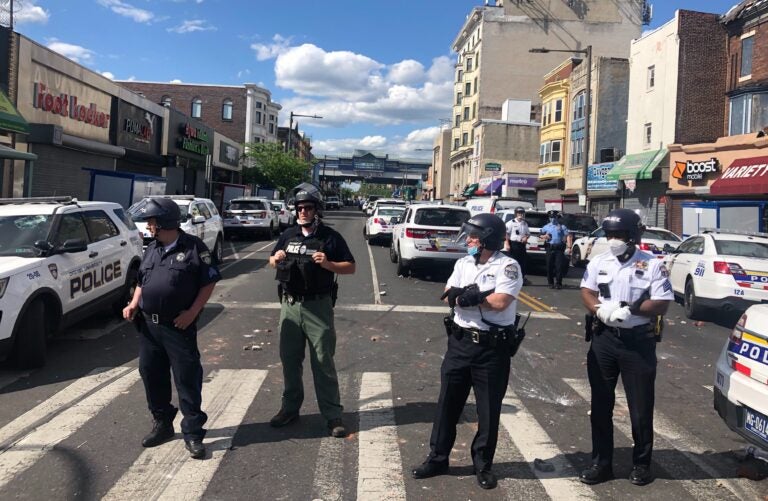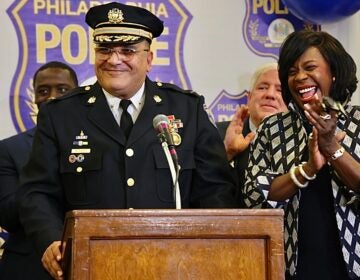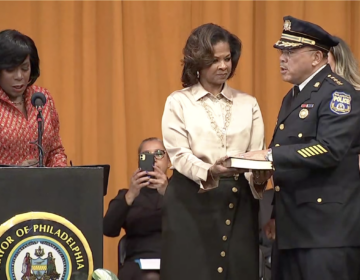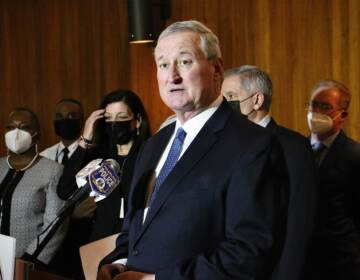West Philly recalls police siege of rubber bullets, tear gas as City Council moves to ban tactics
“This kind of police violence and disregard for an entire residential neighborhood does not happen in a white neighborhood,” said Rev. Abbey Tennis.

Officers stand at 52nd and Chestnut streets as protests continue across the city on May 31. (Darryl Murphy/WHYY News)
A somber tone emanated through the screen during a virtual hearing hosted by City Council’s Public Safety Committee as witnesses recounted police violence that took place on May 31 in West Philadelphia and June 1 on I-676.
Witnesses and residents painted pictures of militarized police indiscriminately firing tear gas canisters and rubber bullets down the 52nd Street corridor and the surrounding neighborhoods with little regard for whom they would hit or affect.
Bedjy Jeanty, a West Philadelphia resident, was one of many who recounted personal experiences with police violence. He said he went to 52nd Street to protest and soon after hostile police officers arrived, some calling them “monkeys” and “n-words.” He said he later got hit with a rubber bullet, struck with a baton, and pepper-sprayed that day.
“Everyone was running for their lives,” he said. “Everyone was scared.”
Abbey Tennis, a white resident in the mostly Black neighborhood, said police shot tear gas canisters at bystanders and residents for hours “too many times to count.” She said she saw police shoot tear gas near children, past elders “holding themselves up with their canes outside their homes,” and even toward “people sitting in wheelchairs outside their homes with no ability to run away.”
“Police were targeting bystanders with hundreds of rounds of tear gas,” said Tennis, a minister at the First Unitarian Church in Center City. “This kind of police violence and disregard for an entire residential neighborhood does not happen in a white neighborhood.”
During the chaos of that day, some broke into businesses to loot, but some witnesses pointed out that those who partook in theft were in the minority. Furthermore, Damone Jones Sr., a pastor at Bible Way Baptist Church on 52nd Street, said police stood by as a sneaker store was “being looted in plain sight and just feet away from a platoon of officers.”
Resident Shakira King said a SWAT officer fired a tear gas canister at her and a group of people as they tried to protect Hakim’s Bookstore, a staple on the corridor, from looters.
“These kinds of super violent attacks help no one,” she said. “My hope is that not only does this never happen again, but that Philadelphia’s local government will no longer support the increasing of a budget to allow things like SWAT cars and tear gas guns to be purchased, before its citizens have schools that function properly, affordable housing, and access to affordable health care.”

Subscribe to PlanPhilly
The hearing included similar accounts from those who protested on I-676 on June 1, where police unleashed tear gas on demonstrators trying to evacuate up an embankment. Both incidents resulted in civil lawsuits from about 150 litigants against the city over the use of force and chemical weapons by the Philadelphia Police Department.
During the hearing, City Councilmember Helen Gym announced that she and her fellow Public Safety Committee members plan to introduce a bill that would ban the police use of tear gas, rubber bullets and other “less lethal” munitions in response to demonstrations.
Commissioner Danielle Outlaw, officials from the Police Advisory Commission, and the Philadelphia Commission on Human Relations also listened in on the session.
Gym said “these testimonies weighed heavily on me,” and “I take them to heart.”
“I want to make a commitment that this is a start, it is not the end,” said Gym of the proposed legislation. “It is the start of a process of how we repair trust, how we reimagine policing and public safety. It is a process of healing and accountability.”
A follow-up hearing is planned for Oct. 20.
WHYY is your source for fact-based, in-depth journalism and information. As a nonprofit organization, we rely on financial support from readers like you. Please give today.







